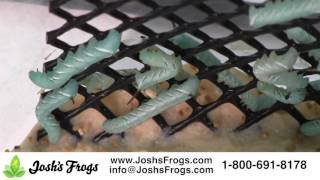
So, let’s talk about how to transform your outdoor space into a hornworm-friendly haven for its predators. This isn’t just a gardening tip; it’s about fostering a lively community where each part plays a role. Think of it like hosting a dinner party where the guests you want are the ones who keep the pests away while enjoying your beautiful garden. By the end of this, you’ll feel confident in your ability to create a sanctuary for these beneficial creatures.
Understanding Hornworms and Their Predators
Before diving into the habitat creation, let’s get familiar with who we’re dealing with. **Hornworms** are the larvae of several moth species, with the most common being the tomato hornworm. They’re notorious for devouring tomato plants, peppers, and eggplants, leaving behind a trail of devastation. But, here’s the thing: they’re not just pests; they’re also key players in the food chain.
Now, enter the predators—like parasitic wasps and certain birds—that thrive on hornworms. Parasitic wasps lay their eggs inside the hornworm, and when the eggs hatch, the wasp larvae feed on the hornworm. Gross, I know, but it’s nature’s way of keeping things in check. Some birds, like blue jays and sparrows, also enjoy feasting on these pests. By encouraging these predators, you’re setting up a natural defense for your garden.
Choosing the Right Location
Creating a hornworm-friendly habitat starts with choosing the right location in your garden. Look for areas that receive both sun and shade because these predators appreciate a mix of environments. A sunny patch will help plants thrive while shaded spots provide shelter. Think of it as offering a cozy lounge area in your garden where your guests can relax before diving into a hearty meal of hornworms.
Also, consider the proximity to your vegetable garden. The closer the habitat is to your plants, the easier it will be for the predators to patrol for hornworms. Just like providing food and drinks to your guests in a party, you want to make it easy for your predators to access their meal.
Planting Nectar-Rich Flowers
To attract those beneficial predators, you need to include nutrient-rich plants in your habitat. **Nectar-rich flowers**, like lantana, yarrow, and dill, are perfect choices. These plants not only provide food for adult wasps and other pollinators but also create a colorful environment that enhances your garden’s aesthetic.
Planting in clusters rather than in isolation can make these flowers more appealing. Think about it: if you’re throwing a party, wouldn’t you want a delicious spread of food in one spot? Bees and other beneficial insects are more likely to visit if there’s plenty of nectar in a concentrated area.
Creating Shelter and Nesting Areas
Beyond food, your predators need a safe space to hide and breed. You can create shelter in a few different ways:
- Dense shrubs: Consider planting native bushes that provide a natural habitat.
- Brush piles: Leaving a pile of twigs and leaves in a corner of your garden can offer a warm sanctuary.
- Insect hotels: Building or buying a small insect hotel can encourage wasps and other beneficial insects to take up residence.
Shelter is crucial, especially for those tiny creatures that might get easily spooked. A cozy spot allows them to rest, breed, and keep an eye out for snack opportunities—like hornworms!
Water Sources and Humidity
While predators need food and shelter, they also require water. Without a source of **moisture**, they’ll struggle. Consider adding a small birdbath or a shallow dish with pebbles. The pebbles give them a place to perch while sipping water—kind of like a tiny watering hole for your garden’s wildlife.
Keeping the area a little humid also helps. You can achieve this by mulching around your plants. Mulch not only retains soil moisture but also provides cover for beneficial insects, helping create a stable environment that encourages them to stick around.
Organic Pest Control Practices
To truly support your hornworm predators, it’s wise to adopt some organic pest control practices. Chemicals can harm not only the pests but also their natural enemies. Here’s how you can maintain a healthy ecosystem naturally:
- Avoid pesticides: Use insecticidal soaps or neem oil instead if you need to control other pests.
- Hand-picking: Check your plants regularly and remove hornworms by hand. You might even want to toss them in a bucket for the birds.
- Companion planting: Growing certain plants together can repel pests naturally, protecting your hornworm predators.
By opting for these methods, you’re not only protecting your plants but also ensuring the predators have the best chance of thriving.
Monitoring and Adjusting Your Habitat
Finally, creating a habitat isn’t a “set it and forget it” project. It’s essential to monitor how things are going. Keep an eye on your plants and look out for any signs of hornworms. More hornworms might mean that your predators have either left or aren’t thriving as you’d hoped.
Adjust your habitat as needed. If you notice your nectar plants aren’t attracting enough visitors, try adding more variety or changing locations. After all, every garden has its unique vibe, and sometimes it just takes a little tweak to get it just right.
Closing Thoughts
Creating a hornworm-friendly habitat for predators is not just a beneficial choice for your plants; it’s a way to embrace the natural balance of your garden. By cultivating a space filled with nectar-rich flowers, adequate shelters, and organic practices, you’re inviting a whole community of helpful creatures into your world. So, grab your gardening gloves and get to work. Your plants—and the predators—will thank you for it!
